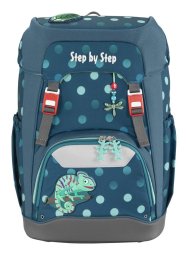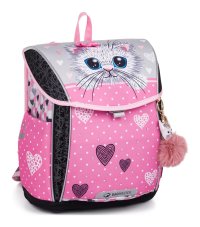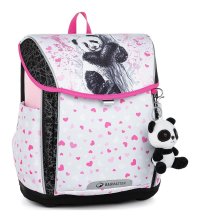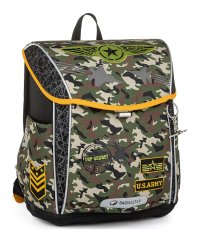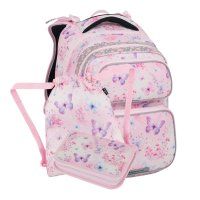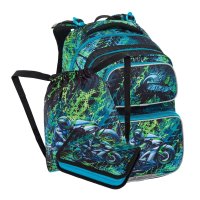Choosing the first school bag is a major event for many parents, often associated with nostalgia, anticipation, and a little nervousness. We want the best for our little scholars – for the bag to suit them, for them to like it, and above all, for it to be comfortable, safe, and not harmful to their backs. It's not just any backpack; it's a daily companion that will carry not only textbooks and notebooks but also, symbolically, the weight of new responsibilities and joys. We know how important this step is, and that's why we've prepared a comprehensive guide to help you navigate the wide range of options and choose the best school bag specifically for your child. Let's take a look together at what parameters to watch for, what to be careful about, and how to ensure your child steps into the classroom with a smile and a healthy back.
Contents:
- Satchel or School Backpack?
- Key Parameters for Selection
- Ergonomics First
- Weight of the Bag: Every Gram Counts
- Size and Volume: To Fit Everything and Not Get in the Way
- Material and Durability: An Investment That Pays Off
- Safety First: Visibility on the Way to School
- Internal Organization of School Supplies: Clarity and Organization
- Fastening: School Bags Require Simplicity and Reliability
- How to Properly Adjust and Wear the Bag?
- Frequently Asked Questions (FAQ)
- Conclusion and Summary
Satchel or School Backpack? Unraveling the Basic Terms
Before we delve into the details of selection, it's good to clarify the basic terminology. You will often encounter the terms "school satchel" and "school backpack." Although they may seem interchangeable, there are key differences between them that play a role, especially when choosing for the youngest students.
- A school satchel is typically for primary school students, especially first-graders. It is characterized by a firm, stable structure that holds its shape even when empty. It usually has one main compartment, a clear internal layout, and simple fastening, often with one or two buckles that even small children's hands can manage.
- A school backpack, in contrast to a satchel, is softer and more flexible. Its structure is not as reinforced, which can be an advantage for older children who have more things and need more variable space. School backpacks often offer more compartments and pockets and are popular with older primary school students, middle schoolers, and high school students.
Key Parameters for a Healthy Back and a Happy Scholar – What to Focus On?
Let's take a detailed look at the most important features that a quality school satchel for first-graders should have. These parameters are crucial for the healthy development of a child's spine, comfortable wear, and the overall satisfaction of your little scholar.
Tip: Remember that your child will be wearing the bag. It is therefore important that they like it. Show them several suitable models that meet your criteria for ergonomics and safety, and let them choose the one that appeals to them most in terms of design.
Ergonomics First
The ergonomics of a school bag are absolutely fundamental. A child's spine is developing, and an incorrectly chosen or poorly worn bag can lead to poor posture, back pain, and in worse cases, more permanent problems like scoliosis.
- Anatomically Shaped and Padded Back System:
The back of the bag should follow the natural curve of the spine. Look for bags with a firm but sufficiently padded back panel. Ventilation grooves or breathable material are also important to prevent excessive sweating of the back, especially in warmer months. Some modern bags have a height-adjustable back system, which allows the bag to be adapted to a growing child, thus extending its usability. - Adjustable Shoulder Straps:
They must be wide enough, ideally at least 4 centimeters, and softly padded so they don't dig into the shoulders. The key is the ability to easily adjust their length so that the bag sits firmly on the back, with its top edge at shoulder level and the bottom part not extending below the hip level. The straps should be symmetrical and run over the center of the shoulders. Some bags also have upper stabilizer straps that allow the top of the bag to be pulled closer to the back. - Chest Strap:
Often underestimated, but an extremely important element. It connects the shoulder straps on the child's chest and prevents them from slipping off the shoulders, especially for children with narrow shoulders. It ensures that the bag fits better and the weight is more optimally distributed. The chest strap should be adjustable in height and length to fit the child's body. Its correct position is roughly at the level of the armpits. - Hip Belt:
Similar to hiking backpacks, it also plays a significant role in school bags, especially for first-graders or larger ones. It helps transfer part of the bag's weight from the shoulders to the pelvis, significantly relieving the back and shoulders. If the bag has a hip belt, make sure it is sufficiently padded and easily adjustable. Some hip belts are removable, which can be practical if the child prefers to wear the bag without it, although its use is generally recommended. - Ergonomics Certification:
Look for bags that have undergone independent testing and received an ergonomics certificate. Internationally recognized is the German AGR (Aktion Gesunder Rücken) certificate. These certificates are a guarantee that the bag meets strict ergonomic requirements for healthy carrying.
Tip: Also check out our range of backpacks and satchels for primary school students. For older students, we have backpacks for middle school and student backpacks.
Weight of the Bag: Every Gram Counts
Children carry a lot to school. Textbooks, notebooks, a pencil case, lunch, a drink, slippers... The weight of a filled bag can easily exceed a reasonable limit. Therefore, the weight of the empty bag is a very important parameter.
- The ideal weight of an empty bag for first-graders should ideally not exceed 1200 g.
- The total weight of a filled bag, according to experts, should not exceed 10 to 15% of the child's body weight.
There are several tips on how to keep the weight of the bag in check:
- Choose a bag with a light but sturdy construction.
- Teach your child to take to school only the things needed for that day.
- If possible, leave some textbooks or supplies at school.
- Choose lightweight lunch boxes and water bottles. Carry the water bottle empty and fill it at school, if conditions allow.
- Regularly check the contents of the bag with your child and remove unnecessary items that may accumulate.
Size and Volume: To Fit Everything and Not Get in the Way
The right size of the bag is just as important as its ergonomics and weight. The bag should not be too big or too small. It should fit the child's body and the amount of things they will carry.
How to determine the right size? The bag should not be wider than the child's shoulders. Its top edge, as mentioned, should not extend beyond the shoulder line, and the bottom edge should not go below the hip level, ideally ending above the tailbone.
The recommended volume of the bag varies with the child's age and the amount of schoolwork. For a first-grader, a volume of around 15 to 20 L is usually sufficient.
Tip: When trying a bag on a child, always check how it fits on their back not only empty, but also with some weight, such as a few books.
Material and Durability: An Investment That Pays Off
A school bag is subjected to daily wear and tear, so it should be made of high-quality and durable materials. Investing in a durable bag pays off because it will last longer and better protect its contents.
The most commonly used materials for making school bags are polyester and nylon. Both of these synthetic materials are lightweight, strong, and resistant to abrasion and tearing. They are often treated with a special finish that increases their water resistance/repellency.
A sturdy base is another important element. It should be made of a durable, washable material and is often equipped with plastic feet. These protect the bottom of the bag from moisture and dirt when the child places it on the ground, and at the same time, they increase its stability so it doesn't tip over.
Safety First: Visibility on the Way to School
The safety of the child on the way to and from school is a priority for parents. A school bag can significantly contribute to this safety.
A sufficient amount of reflective elements is an absolute must. These elements reflect light from car headlights and ensure that the child is visible even in reduced visibility, such as at dusk, in fog, or in the rain. Reflective elements should be placed on all sides of the bag – on the front, on the sides, and on the shoulder straps. The larger the area of reflective materials, the better.
Bright colors of the bag also contribute to better visibility of the child during the day. Bright yellow, orange, red, or green are more visible than dark shades.
Tip: Remember that in addition to the bag, it is advisable to supplement the child's clothing with other reflective elements, especially in the winter months when it gets dark early.
Tip: Children's visibility on the roads can be increased by school backpack accessories (pictures, stickers, pendants with reflective elements).
Internal Organization of School Supplies: Clarity and Organization
A well-thought-out internal layout of the bag makes it easier for the child to organize school supplies and also helps to correctly distribute the weight of the contents.
- The number of compartments and pockets should correspond to the child's needs. For first-graders, one spacious main compartment is often ideal, possibly supplemented by a smaller front pocket. Too many compartments can be confusing for young children.
- Special pockets are very practical. Side pockets are ideal for storing a water bottle or an umbrella. They should be deep and sturdy enough so that the bottle does not fall out. The front pocket is suitable for a lunch box or a pencil case. Some bags have a thermal-insulated pocket for lunch, which keeps food fresh longer.
- Organizers and key clips are other useful details. Small compartments for pencils, a mobile phone, or other small items help maintain order.
How does the layout help distribute weight? Heavier items, such as textbooks and folders, should be placed in the compartment as close to the back as possible. Lighter items, such as a pencil case or a lunch box, can then be placed further from the back, in the front of the bag or in the front pockets. This arrangement helps to keep the center of gravity of the load as close to the child's body as possible, which is the most gentle on the back.
Tip: A simple way to get all the school supplies is with school sets, which, in addition to the bag, also include a pencil case, a shoe bag, and a lunch set. They are often more cost-effective than buying individual items and stand out with a uniform design.
Fastening: School Bags Require Simplicity and Reliability
The fastening of a school bag should be easy for a child to operate, but at the same time sturdy and reliable enough so that the bag does not open on its own.
- For the youngest students, especially first-graders, classic buckles are the most suitable. They can be plastic or metal. A child usually learns to handle them quickly. Some modern buckles have magnetic elements that make fastening easier.
- Zippers are more common on school backpacks or some types of bags for older children. They should be of high quality, with sufficiently large pulls that are easy to grip. It is important that the zippers are smooth and do not snag.
Tip: Find out everything a first-grader needs when starting school and be ready for September!
How to Properly Adjust and Wear the Bag? A Step-by-Step Guide
A properly chosen bag is only half the battle. The other, equally important part, is its correct adjustment and wearing. Even the best ergonomic bag can be harmful if it is not properly adjusted to the child.
- Adjusting the Shoulder Straps
The straps should be adjusted so that the bag fits firmly on the back and its top edge is at shoulder level. They should be neither too loose (the bag would then hang low on the back and pull the child backward) nor too tight (this would restrict movement and cause discomfort). - Tightening the Chest and Hip Straps
The chest strap should be fastened and adjusted to connect the shoulder straps on the chest and prevent them from slipping. It should not be too tight to hinder breathing.
The hip belt, if the bag has one, should be fastened and tightened to sit on the hips (on the hip bones) and transfer part of the weight from the shoulders to the pelvis. - Correct Positioning of the Bag on the Back
The bag should fit snugly against the back along its entire length, with its top edge at shoulder level and the bottom edge ending approximately at the hip level, at most at the tailbone. The bag should not stand away from the back. - How to Properly Distribute Items Inside the Bag?
Heavier items, such as textbooks and large notebooks, belong as close to the back as possible, ideally in the back compartment or pocket. Lighter items, such as a pencil case, lunch, or smaller notebooks, can be placed further from the back, in the front of the bag, or in the front pockets. This arrangement helps to keep the center of gravity of the load as close to the body as possible, which is most gentle on the back.
Tip: Regularly check the adjustment of the bag, especially for growing children. Teach the child how to put on and take off the bag correctly.
FAQ: The Most Common Questions When Choosing a Bag
- How to choose a school bag for a first-grader?
When choosing a school bag for a first-grader, it is important to focus on several key aspects. The bag should have an anatomically shaped back that supports correct posture. Pay attention to the weight - an empty bag should not weigh more than 1.2 kg. Padded, adjustable shoulder straps and ideally a chest and hip belt for better weight distribution are also important. Don't forget reflective elements for the child's safety. The capacity should be sufficient for all school supplies, but at the same time, it should not encourage overloading. - What is the difference between a school satchel and a school backpack?
The main difference between a school satchel and a backpack is in their construction and purpose. Satchels are generally more rigid, with a firmer bottom and back system, which makes them more suitable especially for younger students (grades 1-3), as they provide better support for correct posture. School backpacks, on the other hand, are more flexible, often lighter, and more attractively designed for older children. - What should be the optimal weight of a school bag?
The optimal weight of an empty school bag should not exceed 1.2 kg for younger students. According to experts, the total weight of a filled bag or backpack should not exceed 10-15% of the child's body weight. For a first-grader weighing 20 kg, this means that their school bag with all its contents should not weigh more than 2-3 kg. - What ergonomic features should a quality school bag have?
A quality school bag should include several essential ergonomic features: an anatomically shaped, reinforced, and padded back that follows the natural curve of the spine; padded and height-adjustable shoulder straps at least 4 cm wide; a chest strap for stabilization; and a hip belt for better weight distribution. - How important are reflective elements on a school bag?
Reflective elements are an absolutely key component of a school bag from a safety perspective. Especially in the autumn and winter months, when children go to and from school in the dark, they ensure that the child is visible to drivers from a distance of up to 200 meters. A quality school bag should have reflective materials placed on all sides, not just the front, but also on the sides and back. - How to properly adjust the straps on a school bag or backpack?
Proper strap adjustment is essential for ergonomic carrying of a school bag. Adjust the shoulder straps so that the bag fits snugly against the child's back and its top edge does not extend above the shoulder level. The bottom of the bag should rest in the lumbar region, not on the buttocks. - What should a well-equipped school bag contain?
A well-equipped school bag should have a sufficient number of compartments for organizing school supplies. The main space should accommodate A4-sized textbooks and notebooks. Furthermore, the bag should include smaller pockets for a pencil case, lunch box, and water bottle (ideally with insulation or separated from the books). Special pockets for small items like keys, tissues, or a lunch chip are also practical. - How to distinguish a quality school bag from a low-quality one?
You can recognize a quality school bag by several signs. Check the seams and zippers - they should be carefully crafted, straight, and strong. A quality bag has reinforced corners and a bottom resistant to abrasion. The material should be strong, waterproof, and easy to wash. Look at the shoulder straps - they must be wide enough, padded, and easily adjustable. An ergonomically shaped back with padding is a must. Quality bags also have safety and health certificates. - Is it better to choose a school backpack or a satchel for a middle school student?
For middle school students, a school backpack is usually more suitable than a classic satchel. Older students have better-developed back muscles and need more flexibility. Backpacks are generally lighter, more spacious, and more attractively designed for teenagers. - How often should a school bag be replaced?
A school bag does not need to be replaced every year if it is of high quality and in good condition. Generally, a well-chosen bag should last at least 2-3 years of normal use. The main reason for replacement should be that the child has ergonomically outgrown the bag - the straps are at their maximum and the bag no longer fits properly on the back. Another signal for replacement is damaged ergonomic features, such as worn-out back padding, frayed straps, or non-functional zippers and buckles.
A Proper Bag is an Investment in Your Scholar's Health and Joy
Choosing a school bag may seem like a big challenge, but we believe that with our detailed guide, you will be better able to navigate this issue and choose the best possible option for your child. Remember that the most important criteria are ergonomics, low weight, sufficient size, safety features, and quality materials. While design is important to the child, it should never come at the expense of health and functionality.
We believe this article has provided you with all the necessary information. If you have any further questions or need individual consultation, do not hesitate to contact us at Bagalio. We are here to help you correctly choose a school bag or backpack with which your child will step into a new stage of life with joy, comfort, and a healthy back.
Tip: Don't forget that children's independence can be positively influenced by small things like their own kid's wallet!
Browse our wide range of certified school bags and backpacks at Bagalio.eu and choose the right one for your little hero or heroine!


